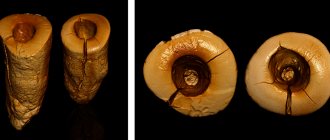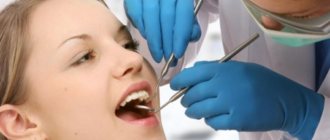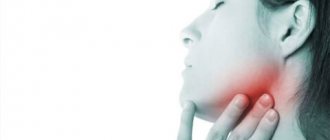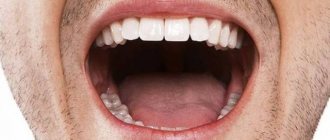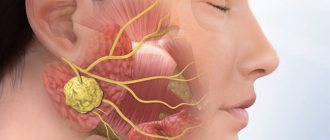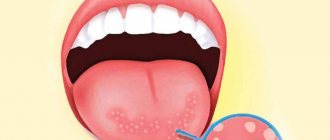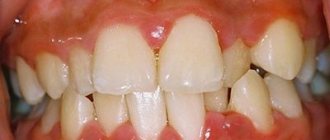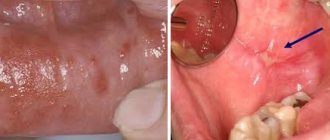Inflammation of the salivary glands is called sialadenitis . Any salivary gland can become inflamed. Most often, an inflammatory process is detected in the parotid glands (parotitis); the sublingual and submandibular glands become inflamed much less often. Usually the disease occurs secondary, as a complication or symptom of another disease, but the primary form of the disease also occurs. The inflammatory process can be either unilateral or bilateral; multiple lesions of the salivary glands are rare. The nature of the disease can be either viral or bacterial.
General information
Sialadenitis is an inflammatory process in the salivary glands. In humans, there are three pairs of salivary glands in the oral cavity, which secrete saliva and discharge them into the oral cavity through special ducts, thereby ensuring a normal digestive process. These are the parotid , submandibular and sublingual glands.
The main functions of saliva are to soften food and also facilitate the process of swallowing it. During the inflammatory process, the production of saliva becomes difficult, and during the process of eating a person feels significant inconvenience. During the development of the disease, pain, swelling of the face, etc. are noted. If the process progresses, a purulent cavity or tumor may form. The disease develops in both young children and adults. Damage to the salivary glands requires consulting a doctor and carrying out the prescribed treatment. The ICD-10 code for sialadenitis is K11.2. How inflammatory diseases of the salivary glands manifest themselves, what treatment is most effective in such cases - this will be discussed in the article.
Which doctor should I contact for help?
Sometimes a dentist can diagnose sialadenitis, which occurs without pronounced symptoms, when examining the oral cavity. But, in the case of a pronounced tumor, which is accompanied by pain and fever, it is worth contacting a therapist as soon as possible, who will perform an examination, prescribe the necessary diagnostics and recommend which doctor to make an appointment with. For uncomplicated inflammation, conservative treatment will be effective, including:
- taking medications (antipyretic, painkillers, and, if necessary, antibacterial or antiviral);
- compresses;
- physiotherapeutic procedures.
In some cases, consultation with a surgeon, endocrinologist or gastroenterologist may be required, depending on the complications that arise.
Consultations with a doctor online Taking care of your health is a life priority for everyone. Communicate with doctors online and receive qualified assistance without leaving your home. Try it
Note! The information on this page is provided for informational purposes only. To prescribe treatment, you must consult a doctor.
Pathogenesis
There are three pairs of major salivary glands in the human mouth. The parotids are located under the auricle in front and are the largest. The submandibular muscles are located under the lower jaw. Accordingly, sublingual - under the mucous membrane of the floor of the oral cavity on both sides of the tongue. These glands produce saliva, which is produced through ducts located in the oral cavity. Saliva ensures normal digestion by softening solid foods.
Reactive-dystrophic pathological processes occur in stages. At the initial stage , there are no symptoms of the inflammatory process, but the lymph stagnates near the blood vessels and ducts. The vessels become overfilled with blood, the lymph around the gland ducts stagnates, and the connective tissue loosens. The acini (terminal sections of the salivary gland) are completely preserved, and mucopolysaccharides and mucin accumulate in them.
The second stage of the disease is characterized by the presence of signs of an obvious chronic inflammatory process. There are signs of atrophic changes in the end parts of the gland, infiltrates are detected in the sclerotic stroma. Fibrous tissue appears near the excretory ducts of the gland. Lymphocytes and epithelial cells accumulate in the lumen of the ducts.
At the third stage, almost complete atrophy of the gland parenchyma occurs, and it is replaced by connective tissue. Blood vessels dilate, the ducts of the gland dilate or narrow if they are compressed by connective tissue.
If the pain is associated with damage to the frenulum
The hyoid frenulum is a mucous membrane that connects the tongue to the base of the mouth. Inflammation can be caused by:
- Diseases occurring in the oral cavity - stomatitis, gingivitis, periodontitis;
- Using incorrect hygiene products: toothpaste, toothbrush, mouthwash;
- Allergies caused by taking medications.
Inflammation of the frenulum under the tongue can also occur as a result of injury to it during brushing teeth, eating (too hot or cold foods), talking loudly, sharply biting the tongue, or careless handling of cutlery.
The reason why it hurts under the tongue may also be a physiological feature. In cases where the frenulum is short from birth, the likelihood of damage increases significantly, and discomfort can occur even while eating.
What can you do
A visit to the dentist cannot be avoided if the frenulum under the tongue hurts. The doctor will examine the damage and prescribe treatment. At home, especially if you can’t immediately visit a specialist, in order to relieve pain, you can rinse your mouth:
- Soda solution (a teaspoon per glass of chilled boiling water);
- Chamomile or sage decoction;
- Preparations: Stomatofit, Rotokan, Chorophyllipt.
Also, if the frenulum under the tongue is inflamed, it is recommended to treat the affected area with Iodinol or place a cotton swab dipped in sea buckthorn oil at the damaged area. Such measures can only be used in cases where you know for sure that the cause of the pain under the tongue is an inflamed frenulum.
Classification
Taking into account the peculiarities of the process, acute and chronic sialadenitis are distinguished.
According to nosological independence, two forms of the disease are distinguished:
- Primary is an independent disease.
- Secondary – a complication in the development of other diseases ( flu , sore throat , etc.).
Taking into account the causes of the development of the disease, the following are distinguished:
- Traumatic – a consequence of injuries and the influence of external factors.
- Radiation – a consequence of irradiation.
- Toxic – a consequence of chemical influence.
- Infectious – develops after infection.
- Allergic.
- Autoimmune.
- Obstructive - a consequence of blockage of the excretory duct by a foreign body or cicatricial narrowing of the duct.
According to the location of the lesion there are:
- Inflammation of the sublingual salivary gland - the inflammatory process of the sublingual gland is also called sublingual gland.
- Inflammation of the parotid salivary gland - in this case, the cheeks swell and there are signs of general intoxication. Sialadenitis of the parotid gland is also called mumps .
- Sialadenitis of the submandibular salivary gland is an inflammatory process of the submandibular salivary gland. When this gland is damaged, calculous sialadenitis , which is characterized by the development of stones in the ducts of the salivary glands or in their parenchyma.
Taking into account the condition of the parenchyma, the following forms of the disease are distinguished:
- interstitial sialadenitis - only stromal damage occurs.
- parenchymal sialadenitis - in addition to the stroma, the parenchyma is also affected.
Depending on the nature of the inflammatory process, the following forms of sialadenitis are distinguished:
- Purulent.
- Serous.
- Hemorrhagic.
- Connective tissue.
- Destructive.
- Granulomatous.
- Fibroplastic.
- Sialadenitis without deformation of the gland.
- Sialadenitis with scarring of the gland.
There are also epidemic and non-epidemic sialadenitis.
- The epidemic form of the disease develops against the background of viral diseases and infections.
- Non-epidemic form - diagnosed if there is a blockage of the salivary gland. Such blockage can develop as a result of injuries, salivary stones, or foreign bodies entering the ducts.
Symptoms of mumps
Mumps is an inflammation of the parotid gland caused by a viral infection. This pathology is characterized by an acute onset of the disease. Parotid swelling occurs, painful when palpated, and a high temperature rises.
There is no specific treatment for this disease. Therapy comes down to relieving symptoms and providing comfort to the sick person.
The main dangers of mumps are its serious complications:
- acute pancreatitis;
- orchitis;
- oophoritis;
- ovarianitis;
- meningoencephalitis.
Reliable insurance against such serious consequences as the development of infertility in men and women, diabetes mellitus or deafness is vaccination.
Causes
There are a number of factors that provoke the development of sialadenitis:
- Wrong approach to oral hygiene.
- Diseases in which the composition and viscosity of saliva changes.
- Postponed surgeries.
- Infectious diseases - influenza, encephalitis , herpes , ARVI , etc.
- Oral diseases – caries , pulpitis , periodontitis , etc.
- Dry mouth.
- Treatment with chemotherapy , radiation therapy .
- Diabetes.
- Disorders of mineral metabolism leading to stone formation.
The epidemic type of the disease develops as a result of infectious processes. Most often, this condition develops with mumps (mumps) . This virus is transmitted from infected people through airborne droplets.
The non-epidemic form of the disease is usually associated with blockage of the glands. This happens with injuries or exposure to foreign bodies. Also the cause of the development of this form of the disease is the so-called salivary stone disease ( sialolithiasis ). If a person develops sialolithiasis of the submandibular salivary gland, the resulting stones may block the ducts.
Treatment
Having established the causes of inflammation of the tongue, the specialist prescribes treatment. In case of inflammation of the salivary glands, the purulent contents are initially removed, then antibacterial agents are injected into the ducts, and the patient is also prescribed antibiotics or sulfonamide drugs orally.
As a rule, therapy is accompanied by rinsing (in each case the doctor selects the optimal solution) and physiotherapy: UHF, Sollux and others. For fever and general malaise, paracetamol or ibuprofen is prescribed.
Surgical treatment methods are used extremely rarely. The operation is performed if there are stones in the duct and they cannot be removed in any other way.
If you experience unpleasant symptoms or discover inflammation or swelling under your tongue, do not look for what it might be. Go to a qualified dentist, he will examine the oral cavity, make a diagnosis, and prescribe adequate therapy. Perhaps pain in the sublingual space is a symptom of another serious disease and consultation with an appropriate specialist will be required.
Monitor the condition of your teeth and mucous membranes, visit the dentist regularly, promptly treat inflammation of the ENT organs and ARVI - such preventive measures will minimize the possibility of inflammation and pain.
Symptoms of salivary gland inflammation
The signs that inflammation manifests largely depend on where exactly the pathological process is localized.
submandibular sialadenitis develops , symptoms may be as follows:
- Pain in the submandibular area, which becomes worse when chewing.
- Swelling in the area of the salivary gland, which may increase.
- Temperature increase.
- Taste of salt or pus.
- Swelling of the face.
- Redness and swelling in the mouth.
If sialadenitis of the sublingual salivary gland , similar symptoms develop. The mouth of the exit ducts of the gland turns red and swelling develops. The pain may be more severe than with submandibular sialadenitis .
With parotid sialadenitis, more pronounced symptoms appear. There is marked swelling and asymmetry of the face, redness of the skin. The patient is bothered by dry mouth. The pain intensifies when palpating the affected area. The temperature rises and the general condition worsens. Shortness of breath may bother you . Palpation of the parotid salivary gland leads to the appearance of cloudy saliva mixed with pus.
Symptoms of salivary stone disease can manifest themselves in a similar way. I am concerned about soreness and dry mouth. At the same time, it is difficult for a person to open and close his mouth.
Xerostomia and hypofunction of the salivary glands: diagnosis and treatment
Hypofunction of the salivary glands, which is manifested by a lack of saliva, can be caused by the influence of a huge number of factors. Causes of xerostomia (a feeling of dry mouth), and therefore hypofunction of the salivary glands, include mouth breathing, smoking tobacco or marijuana, candidiasis, menopause, aging, dehydration, diabetes, radiation therapy and a number of other general somatic disorders (depression, stress, autoimmune neuropathy, CREST syndrome, eosinophilic myalgia syndrome, HIV/AIDS, Lyme disease, lymphoma, multiple sclerosis, Parkinson's disease, primary billiard cirrhosis, primary fibromyalgia, rheumatoid arthritis, Sjögren's syndrome, lupus, SOX syndrome, goiter, hyperlipidemia type 5). At the same time, completely unsubstantiated medications can often be used to stimulate salivation. Complaints of dry mouth are more common among older patients; approximately 80% of patients with xerostomia are people 80 years of age and older, who, in addition to dryness, experience signs of burning and taste disturbances, even when taking certain prescribed medications.
In order to determine the cause of hypofunction of the salivary glands, doctors have to resort to a laboratory blood test, and at times, to a biopsy of the salivary glands, the results of which can make a diagnosis of Sjögren's syndrome, amyloidosis, and sarcoidosis.
Clinical features associated with saliva
Hypofunction of glands
A patient with hypofunction of the salivary glands or with a feeling of dry mouth is characterized by the presence of a number of clinical signs and symptoms. The latter include impaired sensitivity and speech function, burning in the tongue and mucous membranes for no reason, as well as upon contact with certain foods, oral candidiasis, signs of biting the cheeks, cheilitis, caries, erosion and abrasion of dental tissues, dysphagia, food getting stuck between teeth, gingivitis and periodontitis, halitosis, GERD, general weight loss. Such clinical symptoms begin to develop when salivation decreases by at least 50%, and patients may experience both individual symptoms of the lesion and complexes of such symptoms.
When salivation is impaired, saliva parameters also change. It becomes white, foamy, thick, sticky and fibrous. Because of this, the patient may feel the presence of a kind of salivary film on the teeth and mucous membranes. Sometimes patients complain of an excessive amount of saliva in the mouth, which is caused by the fact that its density increases. Normally, the rate of salivation reaches 2-3 ml for 5 minutes; when it increases to more than 1 ml for a minute, sialorrhea is diagnosed. In patients with signs of dry mouth, the normal level of salivation is reduced by approximately one-fold.
With reduced salivation, the oral mucosa becomes dry and during diagnostics, gloves, rollers and even dental mirrors may stick to it. Filiform papillae and fissures may be visualized on the back of the tongue, the presence of which allows a diagnosis of a hairy tongue to be made (photo 1). In the cervical areas of the tooth, areas of carious lesions are often visualized (photo 2), small erythematous spots are diagnosed on the buccal mucosa, where bite marks from the teeth may also be present (photo 3). Patients may also have signs of gingivitis, recession, and periodontitis (Figure 4).
Photo 1. Whitish filiform papillae in a patient with xerostomia. There is also an odor from the mouth.
Photo 2. Carious and associated lesions in a patient with xerostomia.
Photo 3. Traces of biting the cheek.
Photo 4. Signs of gingivitis with severe hypofunction of the salivary glands.
The questionnaire for diagnosing xerostomia was designed specifically to assess existing disorders from a subjective point of view. It includes 11 statements (“I feel dry mouth”, “I have difficulty eating”, “I wake up at night to drink water”, “I feel dry mouth when I eat”, “I drink water to make it easier to swallow food”, “I have difficulty swallowing certain foods”, “The skin on my face seems too dry”, “My eyes feel dry”, “My lips feel dry”, “I have a feeling of dryness in the nasal cavity”), which patients rate using 5 possible options: (1) Never, (2) Hardly ever, (3) Sometimes (4) Quite often or (5) Very often . A score of 11 indicates the presence of moderate xerostomia, while a score of 55 indicates severe xerostomia. If the patient has already been diagnosed with xerostomia, the doctor may ask a few additional questions: Do you think the volume of saliva in the oral cavity is sufficient for you? Do you feel dry when eating? What complications do you experience when swallowing? Do you drink water to make it easier to swallow food? How often?
Objective diagnosis
Patients with mild xerostomia may not experience dry mouth at all, but they may also experience other symptoms of the disorder. As one of the tests to objectify the symptoms of xerostomia, it is recommended to evaluate the rate of salivation at least once a year. Moreover, such an assessment can be carried out both with stimulation of salivation and without any stimulation of the process. To diagnose the rate of salivation, the doctor uses a tube, a separatory funnel, strips for determining pH, and strips for conducting a Schirmer tensile test. The volume of salivary secretion after stimulation can be determined after the patient has chewed paraffin for 1 minute. These data can be compared with data obtained without stimulation, as well as data after administration of a specific drug that stimulates salivation.
Assessment of salivary flow can also be performed using Schirmer strips and pH strips before and after administration of 5 mg pilocarpine. Two hours before the test, the patient should not eat, drink, chew gum, or even brush his teeth. Diagnosis of unstimulated salivation is carried out in the dental chair with the patient in the coachman position, with his hands on the armrests. The patient holds the measuring funnel and tube on his lips, while his eyes should be open, but blinking is not prohibited. Within 5 minutes, saliva should simply flow into the flask and tube. After this, the collected volume of saliva is divided by 5, thus allowing you to set the rate of salivation per minute. Normal average values are 0.3-0.4 ml/minute.
Thus, hypofunction of the salivary glands is diagnosed when the saliva flow rate is less than 0.3 ml/min. When this indicator is less than 0.1 ml/min, then a severe form of hypofunction of the salivary glands is recorded. Normally, the pH of saliva is 7-7.5, that is, it is neutral or somewhat alkaline. A low rate of salivation provokes the development of dental erosion, irritation of the mucous membrane and a burning sensation. When the rate of salivation is normalized, pH values are usually normalized, and vice versa - with hypofunction of the salivary glands, the pH of saliva becomes more acidic.
Treatment
Saliva is a complex fluid consisting of enzymes, proteins, minerals and other components that help maintain a healthy oral cavity. Thus, normalization of salivation is an integral aspect of the complex treatment of dental patients. For patients who cannot control salivary stimulation, saliva substitutes or saliva analogues in the form of lubricants are used. The specific treatment for xerostomia depends on the underlying causative disease. The goal of such therapy is to relieve the symptoms of dry mouth, and to ensure the prevention of associated complications in the form of caries, candidiasis and other lesions. In addition, treatment of xerostomia also helps to slow down the complete loss of salivary gland function, and sometimes even promotes its restoration. At least in autoimmune diseases, with the help of salivary stimulants, it is possible to maintain a certain level of salivary gland function for as long as possible, and a drug such as rituximab even helps restore the structure of the salivary glands in Sjogren's syndrome. Taking dietary supplements such as coenzyme Q10 100 mg per day for 1 month also helps increase salivation and reduces the development of symptoms of dry mouth. Treatment of pharmacologically induced xerostomia is carried out in the same way as treatment of other forms of this disease. This form of pathology, as a rule, is reversible, but the dentist must take into account what kind of drug it was caused by, and what part he takes in the treatment of general somatic pathology. Control of the main symptom of dry mouth can be carried out with pilocarpine or cevimeline, as well as other drugs, depending on the current state of the pathology. The future in the treatment of xerostomia clearly involves genetic engineering, the use of stem cells and tissue engineering, but the principles of therapy remain the same: normalization, optimization of salivary flow, ensuring adequate hydration of the oral cavity and creating conditions for lubrication of all oral structures.
Normalization/optimization of salivary flow rate
Ideally, treatment of hypofunction of the salivary glands involves restoring their function and the physiological rate and volume of salivation. One treatment option is to stimulate saliva production by taking appropriate medications. The latter allow you to increase the initial level of salivation, thus also reducing the risk of developing subsequent complications (caries and candidiasis). Improvement in salivary flow rate can be achieved by taking pilocarpine 5 to 7.5 mg in tablet form three to four times daily or capsule 30 to 60 mg three times daily. Pilocarpine and cevimeline are salivary stimulants that the FDA prescribes for the treatment of dry mouth symptoms. By their nature they are muscarinic agonists. They increase saliva flow and reduce the feeling of dry mouth. The most common side effects with these medications are sweating, frequent urination, and gastrointestinal discomfort. These drugs should not be taken for uncontrolled asthma, narrow-angle glaucoma and acute iritis. They should also be prescribed with caution to patients with severe forms of cardiovascular disorders, Parkinson's disease, asthma or chronic obstructive pulmonary disease.
Polycarpine and cevimeline are cholinergic agonists that stimulate muscarinic-type receptors in the structure of the salivary glands and, to some extent, in the structure of other exocrine glands. Pilocarpine usually begins to work within 20 to 30 minutes, lasts 3 to 5 hours, and has no residual effect. Taking pilocarpine 20-30 minutes before meals with a glass of water allows you to achieve an optimal level of salivation already at the time of eating, facilitating the processes of chewing and swallowing. Taking the drug before bedtime will help relieve symptoms in those patients who are most bothered by dry mouth at night. Cevimeline begins to act in 30-90 minutes and provides an effect for 6-8 hours. This drug, unlike pilocarpine, has a residual effect, and over time, patients experience a higher salivary flow rate. Patients may also notice increased swallowing after starting to take the salivary stimulant. The fact is that the frequency of swallowing decreases with hypofunction of the salivary glands, and returns to normal during the treatment of xerostomia.
Normally, the patient swallows up to 2000 times a day. If the patient cannot restore the speed or required volume of salivation, he may be prescribed artificial saliva. Such drugs are Caphosol (EUSA Pharma), NeutraSal (OraPharma) and SalivaMAX (Forward Science); Aquoral (Mission Pharmacal). They help relieve dry mouth due to certain diseases, inflammation, medications, chemotherapy and radiotherapy, stress, and aging. Aquoral, in addition to relieving xerostomia, also helps solve difficulties with swallowing, speech and changes in taste.
Hydration
Dehydration of the oral cavity is associated with a reduced level of salivation, but the latter may be associated with general dehydration of the entire body. The loss of about 8% of the human body’s water, which is about 4 liters of fluid, provokes the development of an almost complete absence of salivation. Even after rehydration, the function of the salivary glands is restored only after 24 hours. During this period, saliva can be replaced by drinking 64-80 ounces of drinks that do not contain alcohol or coffee. The volume of fluid required can also be determined by dividing the patient's weight (in pounds) by two to obtain the number of ounces of fluid that should be drunk daily.
Oral lubrication
Since salivary stimulants do not restore the physiological function of saliva, sometimes patients find it necessary to use additional lubricants to relieve discomfort during speech or swallowing. These types of drugs include ACT Dry (Chattem Inc.), Allday Dry Mouth Spray (Elevate Oral Care), Biotene Oralblance (GlaxoSmithKline), Entertainer Secret Throat Relief (KLI Corp.), MedActive Oral Relief (MedActive Oral Pharmaceuticals, LLC), MighTeaFlow (Camellix), MI Paste (GC America), Moi-Stir Mouth Moistening Spray (Kingswood Labs, Inc.), Mouthe Kote (Parnell), Oasis (Gebauer Consumer Healthcare), Orajel (Church and Dwight, Inc.), Salese ( Nuvora Inc.), Salivart Synthetic Salica (Gebauer Consumer Healthcare), SalivaSure Saliva Substiture Tablets (Scandinavian Pure and Naturals), Spry Rain mouth spray (Xlear, Inc.), Stoppers4 Dry Mouth Spray (Woodridge Labs), Xerostom products (Practicon) . Patients may be encouraged to try new products to find the ones that work best for them. Rinsing the mouth with salt water or salt water (1/2 teaspoon) and sodium bicarbonate (1/2 teaspoon) diluted in 8 ounces of water helps cleanse the mouth, neutralize acids, and remove plaque. A drop of mineral oil or glycerin placed on the tongue can completely spread throughout the oral mucosa and improve the patient's comfort level. Oral care recommendations also include drinking plenty of water, brushing your teeth at least twice a day, chewing sugar-free gum, visiting your dentist regularly, and not smoking, caffeine, or alcohol.
Stimulation of salivation - electrical stimulation
Transcutaneous electrical nerve stimulation (TENS) applied to the parotid gland for 5 minutes increased salivary flow in 68-81% of patients in the study. Various types of TENS machines are available for this purpose and have been approved by the FDA. They are portable analogues of the ballpoint pen shape that produce electrical impulses. These can already be purchased in Europe and Australia; in the USA they have not yet undergone final certification procedures.
Behavioral changes
The dentist's recommendations for treating xerostomia may require changes in certain aspects of the person's behavior. The latter include drinking water more often, using various fluoride-containing topical preparations, as well as various rinses, avoiding sugar-containing chewing gum, and using saliva-replacing gel-lubricants, sprays, and moisturizers. These products can be used as often as needed because they do not react with prescription medications and generally have no side effects unless the patient is sensitive to a particular ingredient. Studies have shown that patients prefer to use saliva stimulating drugs rather than salivary substitutes. In addition, dentists may recommend that patients with dry mouth rinse with salt water, eat ice chips, and swallow small amounts of liquid frequently.
In addition, chewing also stimulates the flow of saliva, so eating certain foods daily, such as raw carrots, can help treat xerostomia. You should avoid cigarettes, alcohol, caffeine and spicy, salty or acidic foods, as well as refined carbohydrates (sugar) in your diet if you have symptoms of dry mouth. Patients with xerostomia should take good oral care through frequent brushing, flossing, and fluoride-containing toothpastes and gels. For selected patients at increased risk of developing dental caries, mouth guards can be made for overnight fluoridation treatments. Moisturizing gels can also be used once or twice within an hour of bedtime to reduce the level of discomfort after the mouth guard.
conclusions
Patients with xerostomia or hypofunction of the salivary glands can be diagnosed based on the presence of certain clinical symptoms and the results obtained during an objective diagnosis of the level and condition of salivation. Current treatment options for xerostomia include taking certain medications to manage symptoms and prevent potential complications. Such medications include salivary stimulants, artificial saliva, lubricants, rinses, sprays and gels. Stimulation of salivation can also be achieved through electrical stimulation. Treatments such as gene therapy, stem cell therapy or tissue engineering may become the mainstay in the future for correcting salivary gland dysfunction.
Author: Susan L. Zunt, DDS, MS
Tests and diagnosis of sialadenitis
Diagnosis of sialadenitis is carried out using clinical, instrumental and laboratory methods.
The essence of clinical methods is the collection of complaints and anamnesis. The doctor also examines the patient.
Laboratory methods - a general blood and urine test, a biochemical blood test are performed. A study of saliva is also carried out, in which, during the inflammatory process, leukocytes and an admixture of pus are found.
Hardware methods - diagnosis of diseases of the salivary glands involves, first of all, sialography with contrast, that is, x-rays of the gland. With the help of such a study, stones, narrowing of the lumen of the excretory duct, as well as other obstacles to the normal secretion of saliva are determined.
CT, MRI - it is advisable to carry out if the presence of stones is suspected.
Ultrasound - allows you to determine the structure of the gland and the characteristics of the inflammatory process.
Thermosialography – the temperature of the gland is measured.
Salivary gland biopsy - performed under ultrasound guidance.
Sialendoscopy.
Treatment with folk remedies
Traditional methods in the treatment process can only be used as auxiliary ones. It is advisable to use the following methods of traditional treatment:
- Rinsing the mouth - for this purpose, a solution of soda and salt can be used (1 teaspoon of salt and soda for 1 glass of water). It is also recommended to rinse the mouth with infusions of herbs - sage, oak bark, calendula, chamomile. To prepare the infusion for rinsing, 2 tbsp. l. raw materials should be poured into 3 liters. boiling water Leave for an hour and rinse your mouth several times a day. In case of purulent processes, rinsing is contraindicated.
- To stimulate salivation, it is recommended to consume lemon juice, cranberry juice, and chewing candies.
- 5 tbsp. l. pine needles pour 1 liter of water, bring to a boil, leave and take 50 ml 2 times a day.
Diet
Diet to boost immunity
- Efficacy: therapeutic effect after 3 weeks
- Terms: 1-3 months or more
- Cost of products: 1600-1800 rubles. in Week
During the treatment period, it is recommended to eat properly to strengthen the immune system. Sometimes doctors advise sticking to the so-called salivary diet. However, if a patient is diagnosed with calculous sialadenitis, then in this case it is necessary to carry out mechanical removal of stones, since nutritional correction will not help cure the calculous type of disease.
The salivary diet involves introducing the following products into the menu:
- Sauerkraut, sour berry fruit drinks, lemon juice, pickles.
- Citrus.
- Sour lollipops.
- Fresh vegetables.
- Juices from cabbage, carrots.
- Rose hip decoction.
You need to exclude from your diet foods that contribute to the formation of stones:
- Cheeses, cottage cheese.
- Tofu.
- Almonds, sesame.
- Fish.
- Milk.
